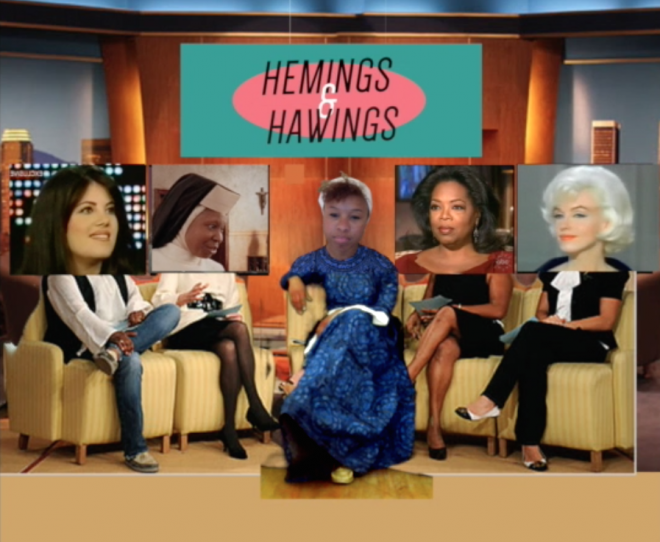Take Two: The World of Marisa Williamson
Lynnette Miranda shares the work of Marisa Williamson, whose videos and performances blend reality and fiction to create a new space for feminism.

Still from Marisa Williamson’s video Hemings and Hawings: A Postmodern Talk Show, 2015. Courtesy the artist.
Often defined by the male gaze, the identity, and image of the female celebrity is constructed and deconstructed, in part, by the spectator. Female celebrities, unlike their male counterparts, are expected to maintain their position as goddesses—balancing virtuosity and sex appeal—while enduring extreme public scrutiny. They are required to sacrifice themselves to the public without question and be grateful for the opportunity. Most times individuals enter the limelight voluntarily, but there are moments when they are unwillingly thrust into celebrity status by the media and its consumers. And in both instances, there is an insidious attitude of ownership.
Marisa Williamson, a New York-based artist, directly examines this sense of ownership of the female public figure through her persona of Sally Hemings, who was quite literally owned by Founding Father Thomas Jefferson as his slave and mistress. Williamson’s performance and video work is inspired by the historical account of Hemings accompanying Jefferson and his daughter to France in the 1780s. It is suspected that during this time Hemings and Jefferson began a sexual relationship, and despite the fact that slavery was illegal in France, Hemings returned with Jefferson to Monticello in Virginia. This distinctive moment where Hemings might have pursued her freedom is what motivated the artist to craft this persona—one that avoids victimization, integrates humor and absurdity, and focuses on autonomy, dignity, and agency, linking them to survival and sacrifice.
The artist’s recent work places the Hemings persona in conversation with other female public figures in order to analyze the unchanging, demeaning depictions of female celebrity that too often flatten the complexities of womanhood. For example in Sally and Monica’s Hot Tub Hangout, 2014, which melds Williamson’s live performance as Hemings with video footage of Monica Lewinsky, Hemings and Lewinsky—known for her affair with the 42nd President of the United States, Bill Clinton—talk about the denial of female satisfaction, self-esteem, and the objectification of women in the spotlight.
Marisa Williamson, Sally and Monica’s Hot Tub Hangout, 2014. Multimedia performance. Courtesy the artist.
In Hemings and Hawings: A Postmodern Talk Show, 2015, a 15-minute video installation, Williamson places Hemings in another contemporary context as the host of a daytime talk show. Modeled after shows like The View, Hemings and her four co-hosts discuss “daily topics” that in her words “move the voices at the margins into the center.” The artist superimposes screens showing the heads of Oprah Winfrey, Monica Lewinsky, Whoopi Goldberg, and Marilyn Monroe onto a still of the seated hosts of The View. The screens remix video clips from interviews, television shows, and films featuring each woman at varying periods in their careers to answer questions and converse with one another. She transports these fictionalized versions of famous women through time and space not to illustrate similarities that inform a faux universal female experience of struggle, but to have a frank discussion about vulnerability, representation, and politics.
Absurdity, of course, plays an important role in this work, creating an imagined radical space where famous presidential mistresses, for example, can participate in an exchange about Hillary Clinton’s 2016 presidential bid. In one segment, Hemings poses the questions, “What does Hillary mean to you? What would her presidency mean for society?” Using heavily edited found video footage, Williams finds humor in the resulting flux of conversational tones and expressions that alternatingly emote coyness, supportiveness, anxiety, and uncertainty. This strategic editing process along with the artist’s comedic timing establish a space for the viewer to interpret multiple messages and, once acclimated, to formulate ideas about the time and cultural contexts in which these women existed and their relationships to feminism.
Marisa Williamson, Hemings and Hawings: A Postmodern Talk Show, 2015. Video. Courtesy the artist.
By choosing the narratives of Lewinsky and Monroe in dialogue with Hemings, Williamson asserts that their stories are inherently feminist, not in spite of their romantic ties to powerful men, but in the public avowal of their needs as women including love, pleasure, and satisfaction.
Williamson’s use of the language of television, such as the laugh track, in Hemings and Hawings highlights the spectator’s complicity in supporting patriarchal structures that would seek to deny or diminish these needs. By including the audience as a player in the video, Williamson acknowledges the power the spectator holds in creating and destroying the public images of these (and other) women. The insatiable appetite the public has for the rise and fall of the female celebrity is not distinct from but rather a reflection of the subjugation of women in all parts of society. Flipping the script on essentialist definitions of feminism, Williamson’s work defines a space, even if fictional, where the histories and legacies of famous women inform our understanding of the intricacies of oppression and reveal our implicit participation in their structures.



